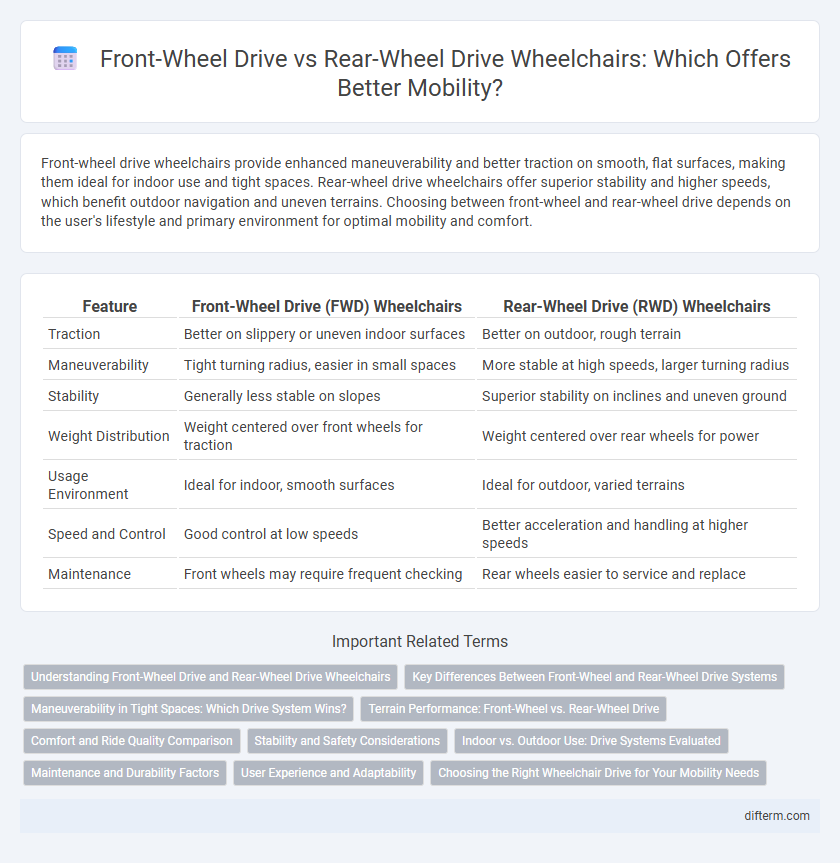Front-wheel drive wheelchairs provide enhanced maneuverability and better traction on smooth, flat surfaces, making them ideal for indoor use and tight spaces. Rear-wheel drive wheelchairs offer superior stability and higher speeds, which benefit outdoor navigation and uneven terrains. Choosing between front-wheel and rear-wheel drive depends on the user's lifestyle and primary environment for optimal mobility and comfort.
Table of Comparison
| Feature | Front-Wheel Drive (FWD) Wheelchairs | Rear-Wheel Drive (RWD) Wheelchairs |
|---|---|---|
| Traction | Better on slippery or uneven indoor surfaces | Better on outdoor, rough terrain |
| Maneuverability | Tight turning radius, easier in small spaces | More stable at high speeds, larger turning radius |
| Stability | Generally less stable on slopes | Superior stability on inclines and uneven ground |
| Weight Distribution | Weight centered over front wheels for traction | Weight centered over rear wheels for power |
| Usage Environment | Ideal for indoor, smooth surfaces | Ideal for outdoor, varied terrains |
| Speed and Control | Good control at low speeds | Better acceleration and handling at higher speeds |
| Maintenance | Front wheels may require frequent checking | Rear wheels easier to service and replace |
Understanding Front-Wheel Drive and Rear-Wheel Drive Wheelchairs
Front-wheel drive wheelchairs offer enhanced maneuverability and easier navigation over uneven surfaces by positioning the drive wheels at the front, providing superior traction on inclines. Rear-wheel drive wheelchairs deliver greater stability and speed, with the main drive wheels located at the back, which improves control during straight-line movement and on smooth pavements. Understanding the differences in wheel placement and traction dynamics is essential for selecting the appropriate wheelchair based on user lifestyle, terrain, and mobility needs.
Key Differences Between Front-Wheel and Rear-Wheel Drive Systems
Front-wheel drive wheelchairs offer better maneuverability and control on smooth indoor surfaces due to the front wheels pulling the chair, enhancing turning radius and obstacle navigation. Rear-wheel drive wheelchairs provide superior stability and traction on uneven outdoor terrain, as the rear wheels push the chair forward, delivering more power and control on inclines. Key differences include front-wheel drive's compact turning capability versus rear-wheel drive's higher speed potential and smoother ride over rough ground.
Maneuverability in Tight Spaces: Which Drive System Wins?
Front-wheel drive wheelchairs excel in maneuverability within tight spaces due to their smaller turning radius and better traction when navigating corners. Rear-wheel drive wheelchairs offer stability at higher speeds but often require more room to turn effectively, making them less suitable for confined environments. For indoor and crowded settings, front-wheel drive systems typically provide superior control and ease of maneuvering.
Terrain Performance: Front-Wheel vs. Rear-Wheel Drive
Front-wheel drive wheelchairs offer superior performance on smooth, flat surfaces by providing better traction and ease of maneuverability, especially indoors. Rear-wheel drive wheelchairs excel on uneven or rough terrains due to enhanced stability and increased power delivery to the rear wheels, allowing for improved obstacle navigation. Terrain adaptability varies significantly between these drive systems, with rear-wheel drive models typically favored for outdoor use and challenging environments.
Comfort and Ride Quality Comparison
Front-wheel drive wheelchairs generally offer improved maneuverability and a smoother ride on smooth surfaces due to better weight distribution over the driving wheels. Rear-wheel drive wheelchairs provide superior stability and performance on uneven terrain, offering enhanced shock absorption and a more comfortable ride in outdoor environments. Comfort and ride quality vary significantly based on user needs, with front-wheel drive excelling in indoor use and rear-wheel drive favoring rougher outdoor conditions.
Stability and Safety Considerations
Front-wheel drive wheelchairs offer enhanced stability on smooth and flat surfaces, reducing the risk of tipping forward during acceleration. Rear-wheel drive wheelchairs provide better control and traction on uneven or rough terrain, improving safety during outdoor navigation. Users should evaluate their typical environment to choose the optimal drivetrain for maximum stability and safety.
Indoor vs. Outdoor Use: Drive Systems Evaluated
Front-wheel drive wheelchairs offer superior maneuverability in tight indoor spaces, allowing users to navigate narrow hallways and doorways with ease. Rear-wheel drive models excel in outdoor environments, providing enhanced stability and better traction on uneven terrain for increased user confidence. Evaluating drive systems based on typical usage conditions ensures optimal mobility performance tailored to either indoor or outdoor needs.
Maintenance and Durability Factors
Front-wheel drive wheelchairs generally require less maintenance due to simpler drivetrain components and fewer exposed parts, making them more durable in everyday use. Rear-wheel drive wheelchairs often experience higher wear on rear wheels and drive mechanisms, necessitating more frequent maintenance but providing better performance on rough terrain. Durability in both systems depends on build quality, usage patterns, and environmental exposure, with front-wheel drive excelling in indoor and smooth surface conditions, while rear-wheel drive offers enhanced stability and power.
User Experience and Adaptability
Front-wheel drive wheelchairs provide enhanced maneuverability and easier navigation over tight indoor spaces, improving user control and comfort. Rear-wheel drive models offer better stability and adaptability to uneven outdoor terrain, supporting users with active lifestyles. User experience depends on individual mobility needs, with front-wheel drive excelling in compact environments and rear-wheel drive suited for versatile adaptability across diverse settings.
Choosing the Right Wheelchair Drive for Your Mobility Needs
Choosing the right wheelchair drive system significantly impacts mobility efficiency and maneuverability. Front-wheel drive wheelchairs excel in navigating tight indoor spaces and climbing obstacles, while rear-wheel drive models offer superior stability and speed on uneven outdoor terrain. Assessing your primary environment and physical needs ensures optimal performance and comfort in daily mobility.
Front-wheel drive vs Rear-wheel drive (wheelchairs) Infographic

 difterm.com
difterm.com